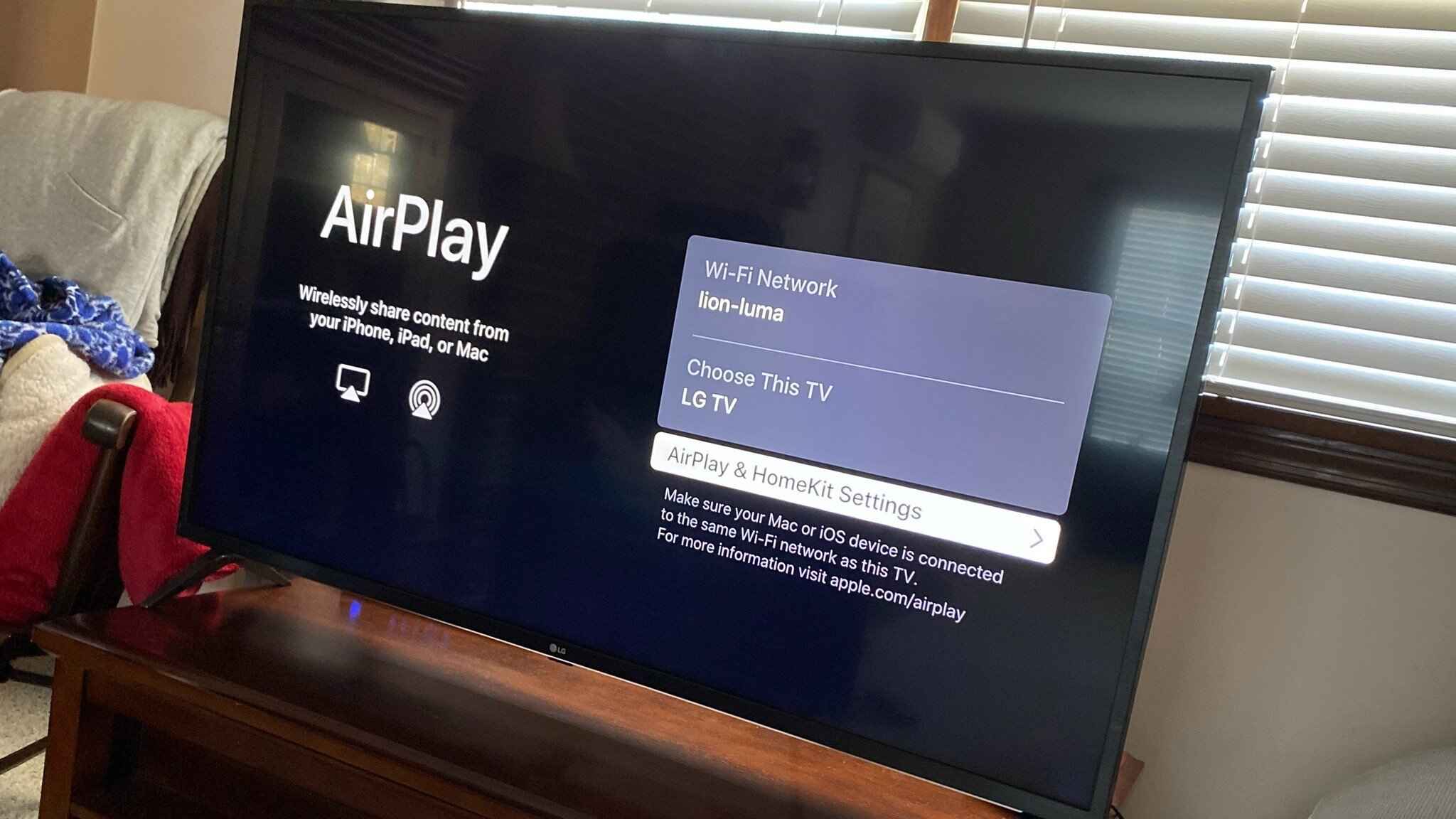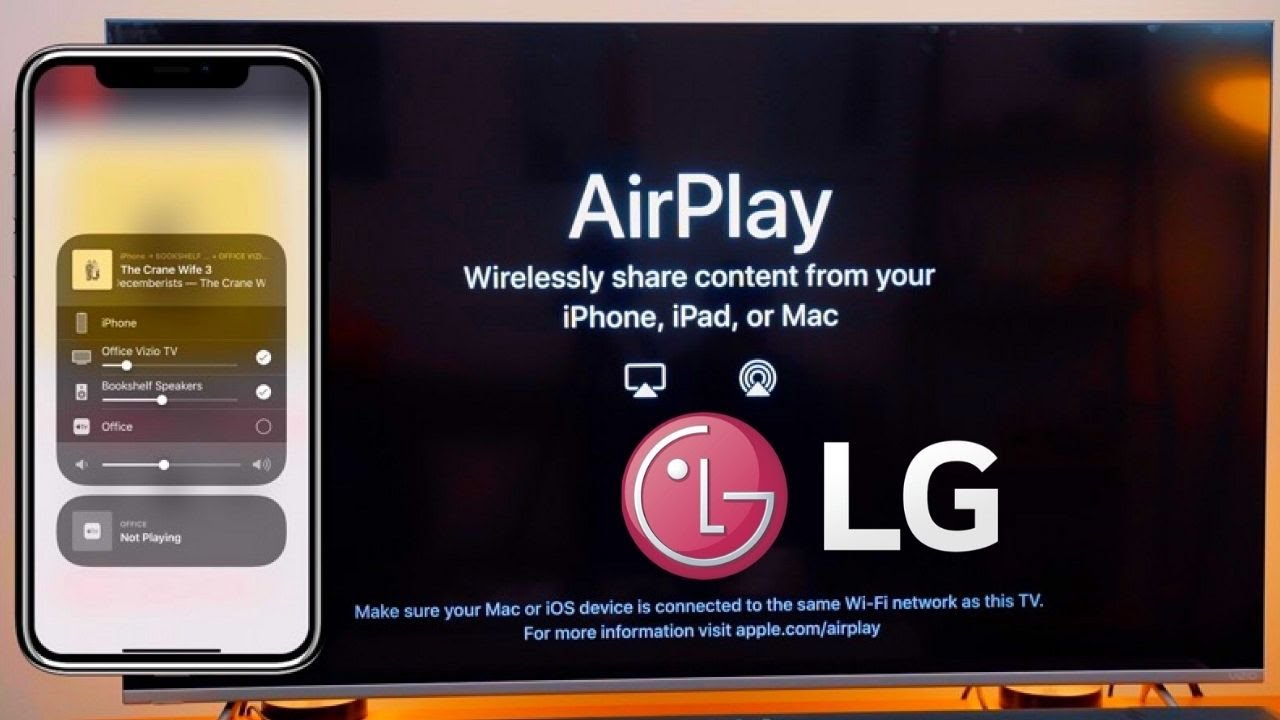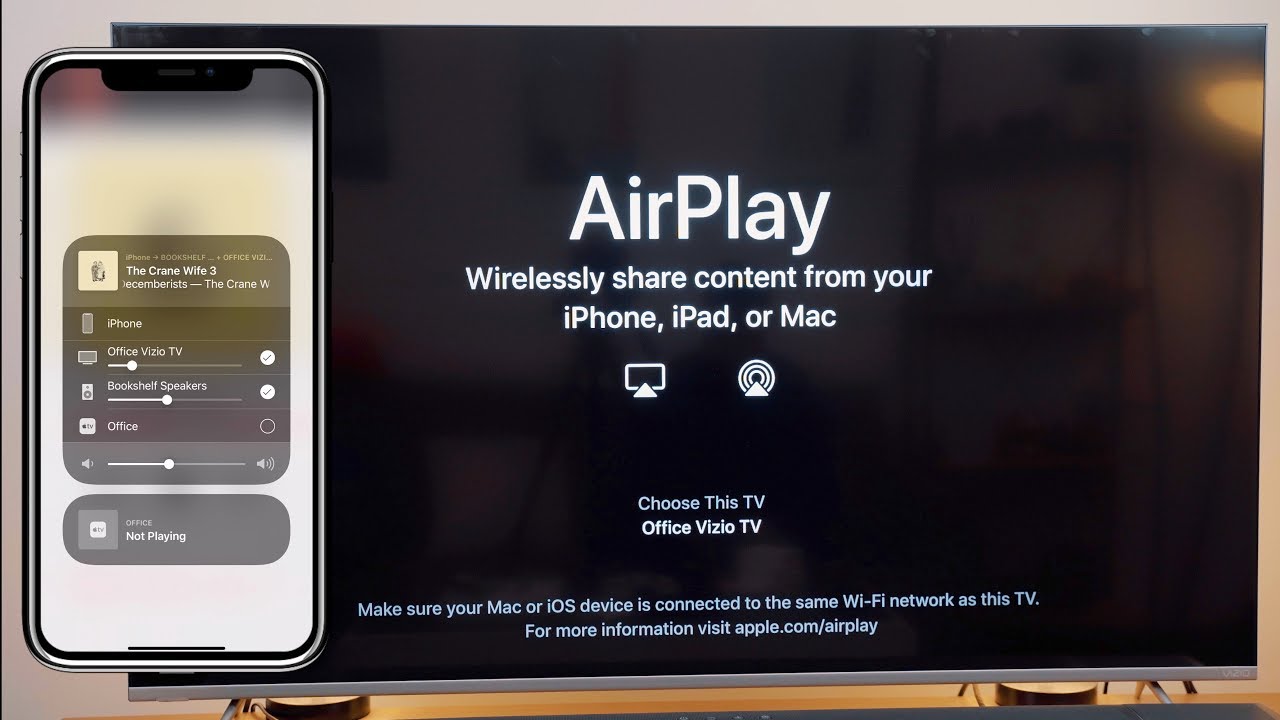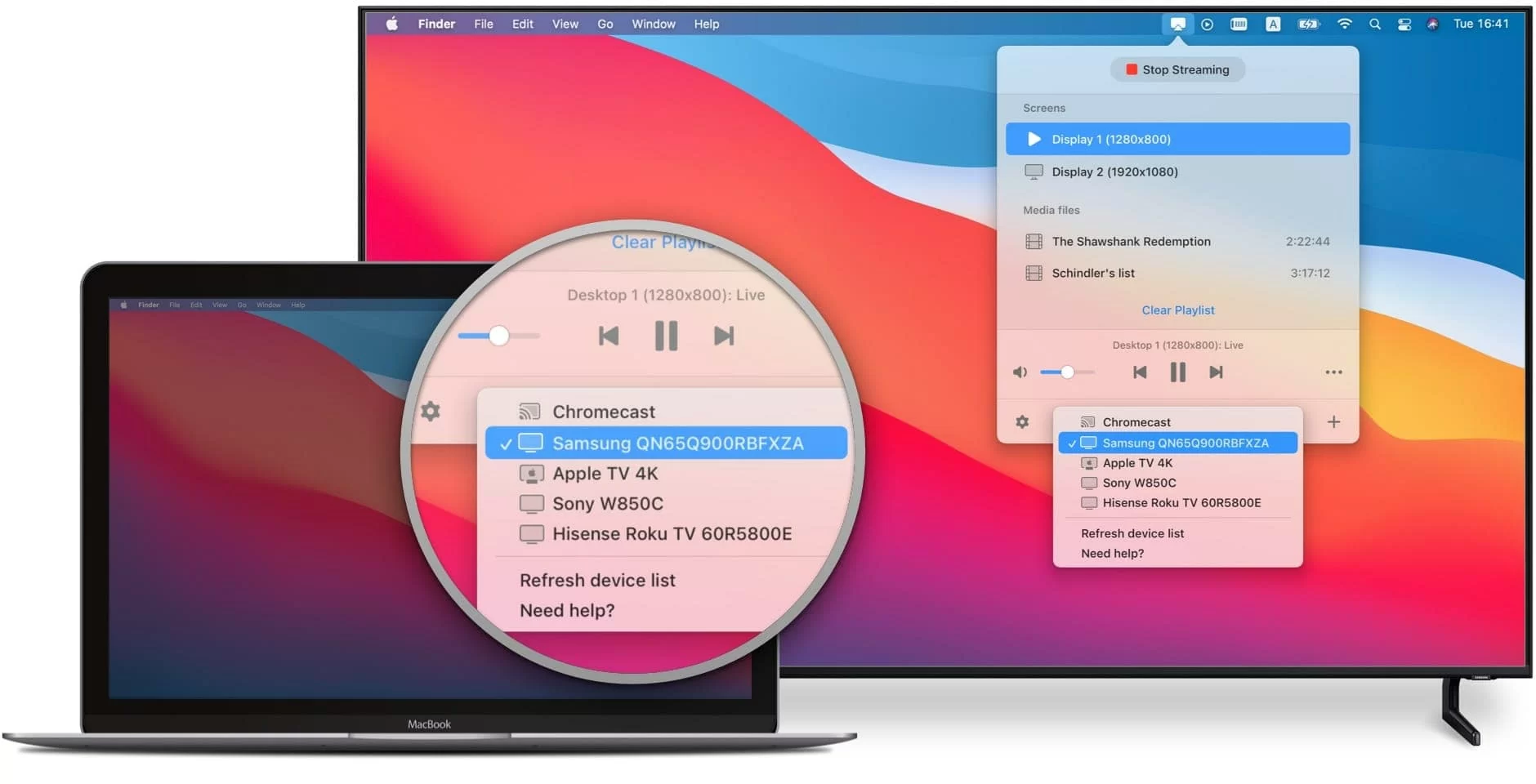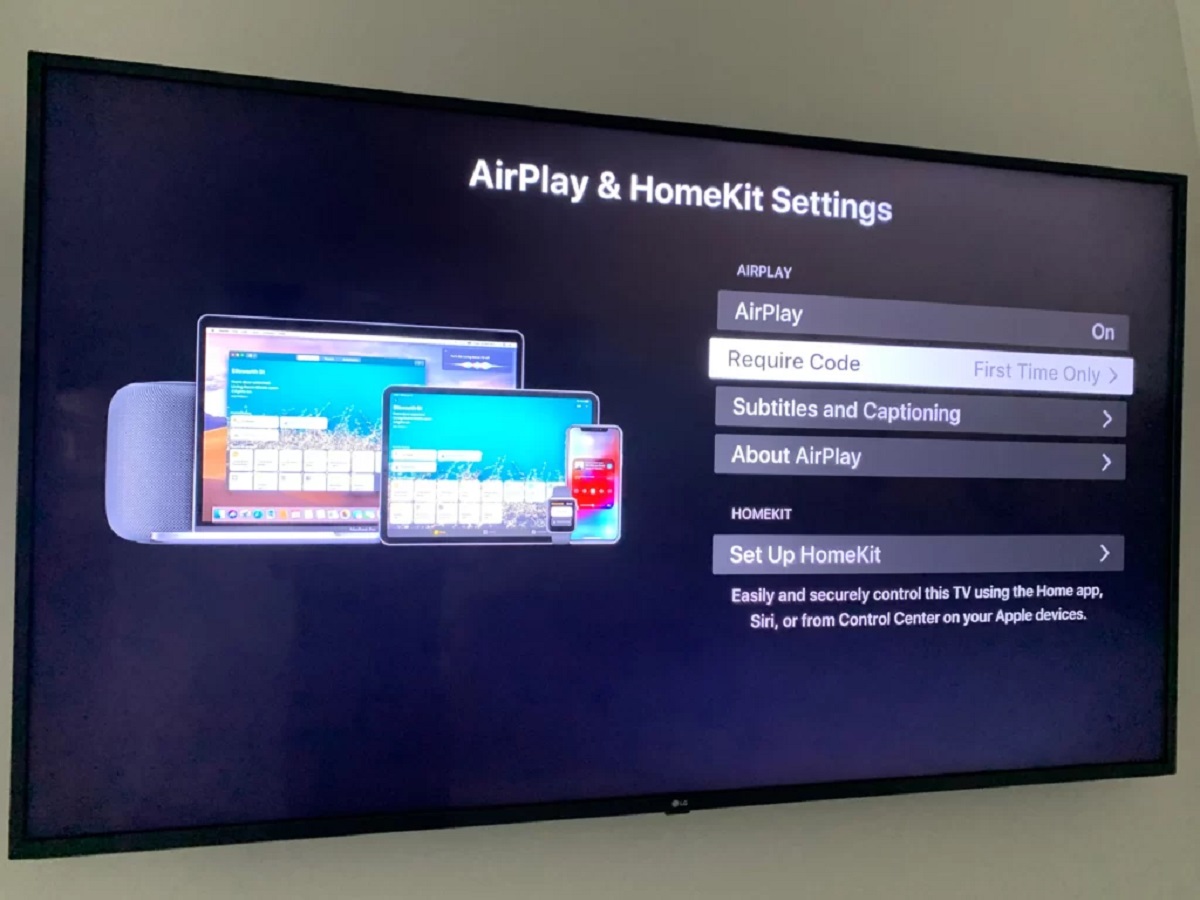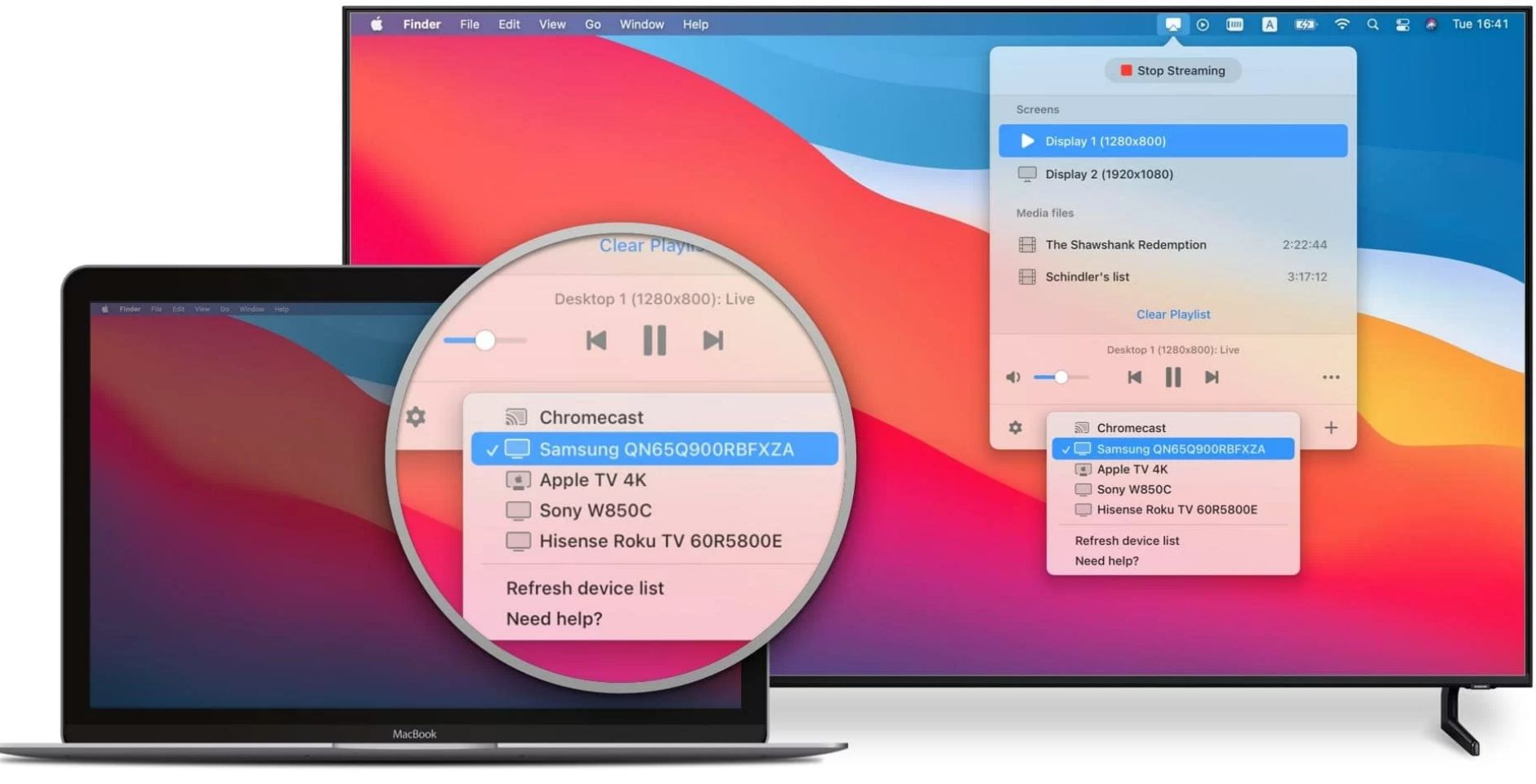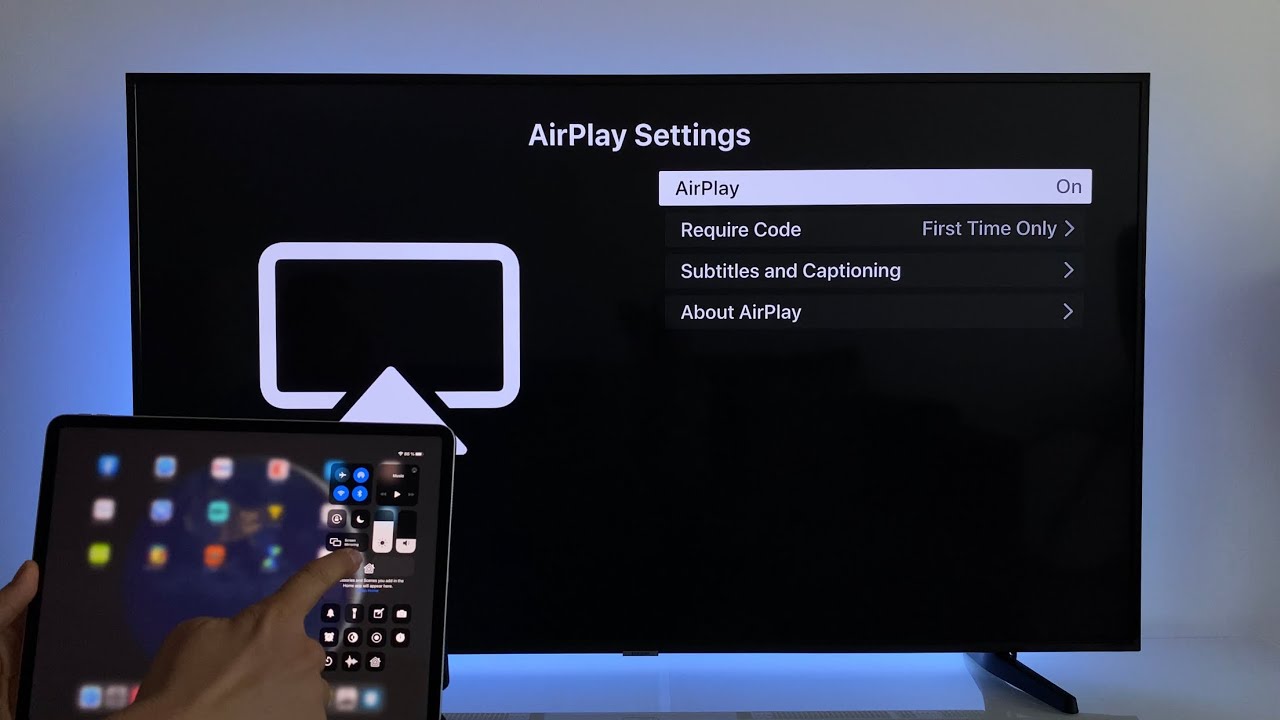Introduction
Welcome to our guide on how to Airplay to a Smart TV. Airplay is a technology developed by Apple that allows you to wirelessly stream content from your iPhone, iPad, Mac, or Windows PC to a compatible Smart TV. It offers a seamless way to enjoy your favorite movies, photos, music, and more on the big screen with just a few simple steps.
If you have ever wanted to display your vacation photos on a larger display or stream videos from your laptop to your TV, Airplay is the perfect solution. It eliminates the need for cables and offers a convenient way to mirror or extend your device’s screen on a Smart TV.
With the proliferation of Smart TVs in recent years, many manufacturers have started supporting Airplay as a built-in feature. This means that you don’t need any additional hardware or third-party apps to utilize Airplay on these TVs. As long as your Smart TV supports Airplay, you can take advantage of this powerful technology.
In this guide, we will walk you through the process of connecting and enabling Airplay on your Smart TV. We will also provide step-by-step instructions for Airplaying from different devices, including iOS devices, Macs, and Windows PCs. Additionally, we will address some common troubleshooting issues to ensure a smooth user experience.
So, whether you’re a tech-savvy person wanting to explore the capabilities of your Smart TV or someone who simply wants to stream content effortlessly, this guide will equip you with the knowledge to master Airplay on your Smart TV.
What is Airplay?
Airplay is a proprietary technology developed by Apple that allows users to wirelessly stream audio, video, and other media content from their Apple devices to compatible devices such as Smart TVs, speakers, and receivers. With Airplay, you can easily mirror your device’s screen or stream content directly to a larger display.
One of the key benefits of Airplay is its simplicity. It provides a hassle-free way to share and enjoy multimedia content without the need for cables or complicated setup procedures. Whether you want to watch a movie, play music, or stream a live event, Airplay makes it seamless and convenient.
When using Airplay, you can choose to either mirror your device’s screen or stream specific media content. Mirroring allows you to replicate your device’s screen on a larger display, making it ideal for presentations, gaming, or browsing photos and videos. On the other hand, streaming enables you to play audio or video files directly on the target device, freeing up your Apple device for other tasks.
Airplay works over Wi-Fi, which means both your Apple device and the target device need to be connected to the same Wi-Fi network. This ensures a stable and reliable connection, allowing for smooth playback and accurate synchronization between devices.
While Airplay was initially designed for Apple products, it has become more widely available on non-Apple devices as well. Many Smart TV manufacturers, including Samsung, LG, Sony, and Vizio, have integrated Airplay functionality directly into their devices, making it easier for users to connect and enjoy their media content.
Moreover, Airplay 2 is the latest iteration of the technology, offering enhanced features such as multi-room audio support. With Airplay 2, you can stream music to multiple compatible speakers simultaneously, creating a synchronized audio experience throughout your home.
In short, Airplay is a versatile and user-friendly technology that enables seamless wireless streaming of media content from Apple devices to compatible devices. Whether you want to share a photo slideshow, watch a movie, or listen to music, Airplay makes it effortless and enjoyable.
Smart TVs that support Airplay
Apple’s Airplay technology was initially developed for deployment on Apple devices, but over time, support for Airplay has expanded to include select Smart TVs from various manufacturers. This means that users can now enjoy the benefits of Airplay without the need for additional devices or cables.
One of the leading manufacturers to embrace Airplay support is Samsung. Many of Samsung’s Smart TVs, particularly those released from 2018 onwards, come with built-in Airplay support, allowing users to easily stream their favorite content from their Apple devices. This includes popular models such as the Samsung QLED series and the Samsung Crystal UHD series.
LG is another major player in the Smart TV market that supports Airplay. LG’s lineup of webOS-based Smart TVs, such as the LG OLED C1 series and the LG NanoCell series, are compatible with Airplay, allowing users to stream content from their iPhones, iPads, or Macs effortlessly.
Sony has also integrated Airplay support into some of its BRAVIA Smart TVs. Models such as the Sony X95J and the Sony A8H OLED series offer Airplay capabilities, enabling users to mirror their Apple devices’ screens and stream media content directly to their TVs.
In addition to Samsung, LG, and Sony, other Smart TV manufacturers including Vizio and TCL have also started incorporating Airplay support into their devices. Vizio’s SmartCast TVs and TCL’s Roku TV lineup feature Airplay compatibility, giving users more options when it comes to choosing a Smart TV that supports Airplay.
It is important to note that while Airplay support is becoming more prevalent among Smart TVs, not all models from a particular manufacturer may support it. Therefore, it is recommended to check the specifications and compatibility of a Smart TV before making a purchase if Airplay support is a key consideration.
Furthermore, to ensure full compatibility and optimal performance, it is recommended to keep the firmware of your Smart TV up to date. Manufacturers often release software updates that include bug fixes and improvements, which can enhance the Airplay experience on your Smart TV.
In summary, Airplay support on Smart TVs has expanded beyond Apple devices, making it more accessible to users who want to enjoy wireless streaming and screen mirroring capabilities. With major Smart TV manufacturers like Samsung, LG, Sony, Vizio, and TCL embracing Airplay support, there are now plenty of options available for users looking for a Smart TV that seamlessly integrates with their Apple devices.
Connecting your Smart TV to the same Wi-Fi network
In order to utilize Airplay on your Smart TV, it is necessary for both your Smart TV and your Apple device to be connected to the same Wi-Fi network. This ensures a stable and reliable connection for seamless streaming and mirroring.
Here are the steps to connect your Smart TV to the same Wi-Fi network as your Apple device:
- Turn on your Smart TV and navigate to the Settings menu.
- Look for the Network or Wi-Fi settings option and select it.
- Scan for available Wi-Fi networks and select your desired network from the list.
- If your Wi-Fi network is password-protected, enter the Wi-Fi password using your Smart TV’s remote control or on-screen keyboard.
- Once the connection is established, your Smart TV will show a confirmation message indicating that it is connected to the Wi-Fi network.
It is important to note that the exact steps may vary depending on the make and model of your Smart TV. However, the general principles outlined above should apply to most Smart TVs.
If you encounter any issues during the Wi-Fi setup process, it is recommended to consult your Smart TV’s user manual or visit the manufacturer’s support website for specific instructions.
Once your Smart TV is successfully connected to the Wi-Fi network, the next step is to enable Airplay on your Smart TV. This will allow your Apple device to detect and connect to your Smart TV for wireless streaming and screen mirroring.
Now that your Smart TV and Apple device are connected to the same Wi-Fi network, you are ready to take full advantage of Airplay and enjoy seamless wireless streaming from your Apple device to your Smart TV.
Enabling Airplay on your Smart TV
To use Airplay on your Smart TV, you need to enable the Airplay feature within the TV’s settings. By enabling Airplay, you allow your Smart TV to be discovered by your Apple device and establish a connection for wireless streaming and screen mirroring.
While the exact steps may vary depending on the brand and model of your Smart TV, here is a general guide on how to enable Airplay:
- Turn on your Smart TV and access the Settings menu.
- Navigate to the Airplay or Airplay Settings option.
- Toggle the Airplay switch to the “On” position.
- Depending on your Smart TV, you may have additional options such as setting a device name or PIN code for Airplay connections. Configure these settings according to your preferences.
Once you have enabled Airplay on your Smart TV, it should be ready to accept connections from your Apple devices. The next step is to initiate the Airplay process from your iPhone, iPad, Mac, or Windows PC.
It is important to note that not all Smart TVs support Airplay, especially older models. Therefore, make sure to check your TV’s specifications or user manual to confirm if Airplay is available on your particular model.
If your Smart TV does not support Airplay, there are alternative methods to wirelessly connect your Apple device to your TV, such as using a third-party casting device or HDMI adapter. However, these methods may require additional hardware or software.
Furthermore, it is always recommended to keep your Smart TV’s firmware up to date. Manufacturers often release software updates that include bug fixes, security patches, and new features, including enhancements for Airplay compatibility. Check your TV’s manufacturer website for the latest firmware updates and install them if available.
With Airplay enabled on your Smart TV, you are now ready to enjoy the convenience and versatility of wireless streaming and screen mirroring from your Apple devices.
Airplaying from an iOS device to a Smart TV
If you own an iOS device, such as an iPhone or iPad, you can easily Airplay your favorite content to a compatible Smart TV. Airplaying from an iOS device allows you to wirelessly stream videos, photos, music, and more, providing a seamless and convenient way to enjoy your media on the big screen.
To Airplay from an iOS device to a Smart TV, follow these steps:
- Make sure your iOS device and your Smart TV are connected to the same Wi-Fi network.
- Open the app or media file that you want to Airplay on your iOS device.
- Look for the Airplay icon, which resembles a rectangle with an upward-pointing arrow. It is typically located in the media playback controls or the Control Center.
- Tap the Airplay icon and a list of available Airplay devices will appear.
- Select your Smart TV from the list of available devices.
- If prompted, enter the Airplay code or PIN displayed on your Smart TV.
- Your iOS device screen should now be mirrored or the media content should start playing on your Smart TV.
Once Airplay is active, you can control playback and volume directly from your iOS device, or you can use your Smart TV’s remote control to manage the content. This allows for a flexible and user-friendly viewing experience.
It’s important to note that not all apps or media files support Airplay. Some apps may have restrictions or limitations when it comes to streaming to external devices. However, most popular streaming apps, such as Netflix, YouTube, and Apple’s own media apps, fully support Airplay.
If you encounter any issues while Airplaying from your iOS device to a Smart TV, check for software updates on both your iOS device and your Smart TV. Keeping your devices up to date can resolve compatibility issues and ensure a smooth Airplay experience.
In summary, Airplaying from an iOS device to a Smart TV is a simple and convenient way to stream media content wirelessly. By following the steps outlined above, you can enjoy your favorite videos, photos, and music on the big screen with ease.
Airplaying from a Mac to a Smart TV
If you own a Mac computer, you can take advantage of Airplay to stream content from your computer directly to a compatible Smart TV. Airplaying from a Mac to a Smart TV allows you to mirror your computer screen or play media files on a larger display, providing an immersive viewing experience.
To Airplay from a Mac to a Smart TV, follow these steps:
- Make sure your Mac and your Smart TV are connected to the same Wi-Fi network.
- Click on the Airplay icon located in the menu bar at the top right corner of your Mac’s screen. It looks like a rectangle with an upward-pointing arrow.
- A list of available Airplay devices will appear. Select your Smart TV from the list.
- If prompted, enter the Airplay code or PIN displayed on your Smart TV.
- Your Mac’s screen should now be mirrored on your Smart TV.
Alternatively, if you want to play specific media files on your Smart TV rather than mirroring the entire screen, you can follow these steps:
- Open the media file that you want to play on your Mac.
- Click on the Airplay icon located in the media playback controls or in the menu bar, depending on the app you are using.
- Select your Smart TV from the list of available Airplay devices.
- The media file should now start playing on your Smart TV.
While Airplaying from a Mac to a Smart TV provides great flexibility and convenience, it’s worth noting that the performance and quality of the playback may vary depending on your Wi-Fi network’s speed and stability. For optimal results, ensure that your Wi-Fi connection is strong.
If you encounter any issues while Airplaying from your Mac to a Smart TV, you can try the following troubleshooting steps:
- Make sure both your Mac and your Smart TV have the latest software updates installed.
- Restart your Mac, Smart TV, and Wi-Fi router to refresh the network connections.
- Check the audio and video settings on your Mac and Smart TV to ensure they are properly configured.
- If possible, reduce interference from other devices that may be using the Wi-Fi network.
In summary, Airplaying from a Mac to a Smart TV is a convenient way to enjoy your favorite media files on a larger screen. Whether you choose to mirror your Mac’s screen or play specific media files, Airplay provides a seamless and immersive viewing experience.
Airplaying from a Windows PC to a Smart TV
While Airplay is primarily designed for Apple devices, there are ways to Airplay from a Windows PC to a compatible Smart TV. By utilizing third-party software or built-in Windows features, you can wirelessly stream content from your PC to the larger screen of your Smart TV.
Here are a few methods you can use to Airplay from a Windows PC to a Smart TV:
- Using third-party software: There are third-party applications available, such as AirParrot and LonelyScreen, that can enable Airplay-like functionality on a Windows PC. These applications allow you to mirror your PC’s screen or stream media content to a Smart TV that supports Airplay. Simply install the software on your PC and follow the instructions provided to establish a connection with your Smart TV.
- Streaming via DLNA: Some Smart TVs support DLNA (Digital Living Network Alliance), which allows for media streaming from a Windows PC. To utilize DLNA, ensure that your Smart TV and Windows PC are connected to the same Wi-Fi network. On your PC, enable sharing of media folders or files, and then access the media sharing functionality on your Smart TV to browse and play the shared content.
- Using built-in Windows features: If your Smart TV supports Miracast, a wireless display standard, you can use the built-in Miracast functionality on Windows 10 to wirelessly connect and mirror your PC’s screen on your Smart TV. Open the Action Center on your PC, click on the “Connect” button, and select your Smart TV from the list of available devices. Follow the on-screen instructions to establish the Miracast connection.
It’s important to note that the availability and functionality of Airplay or Airplay-like features may vary depending on the specific Smart TV model and the compatibility with Windows PC. Additionally, the performance and quality of the Airplay experience can be influenced by factors such as the Wi-Fi network, the PC’s hardware capabilities, and the software used.
If you encounter any issues while Airplaying from your Windows PC to a Smart TV, you can try the following troubleshooting steps:
- Ensure your Windows PC and Smart TV are connected to the same Wi-Fi network.
- Check that both your PC’s graphics drivers and your Smart TV’s firmware are up to date.
- Restart both your PC and Smart TV to refresh the connections.
- Try using a different third-party software or explore alternative methods, such as DLNA or Miracast, if Airplay compatibility is not available.
In summary, although Airplay is primarily designed for Apple devices, there are options available to Airplay from a Windows PC to a compatible Smart TV. Whether through third-party software, DLNA streaming, or native Windows features such as Miracast, you can enjoy wireless streaming and screen mirroring from your Windows PC to your Smart TV.
Troubleshooting common issues
While Airplay is generally a reliable and convenient technology, there can be instances where you may encounter some issues. Here are some common problems that users may face while using Airplay and some troubleshooting steps to help resolve them:
- Connection issues: If you are unable to establish a connection between your Apple device and your Smart TV, ensure that both devices are connected to the same Wi-Fi network. Also, check for any network connectivity issues or interference from other devices. Restarting both your Apple device and Smart TV, as well as your Wi-Fi router, can often resolve connection-related problems.
- Audio or video playback issues: If you experience problems with audio or video playback, confirm that the volume on both your Apple device and the Smart TV is not muted or set too low. Additionally, check that your media file is compatible with Airplay and your Smart TV’s supported formats. If the issue persists, try using a different media file or restarting your devices.
- Slow or choppy playback: If Airplay streaming is slow or the playback is choppy, it may be due to a weak Wi-Fi signal or network congestion. Move your Apple device closer to the Wi-Fi router or consider optimizing your Wi-Fi network by reducing interference from other devices. Ensure that your network has sufficient bandwidth for smooth streaming. You can also try a wired Ethernet connection to your Smart TV if available.
- Incompatible apps or services: Some apps or streaming services may have restrictions on Airplay streaming or may not support it at all. Check if the app or service you are using explicitly allows Airplay streaming. If not, consider using alternative methods, such as screen mirroring through third-party software or connecting your device via HDMI.
- Software updates: To ensure optimal performance and compatibility, keep your Apple device, Smart TV, and any relevant apps or software up to date. Software updates often include bug fixes, performance improvements, and new features. Check for updates on your Apple device, Smart TV, and any Airplay-specific apps.
It’s important to note that troubleshooting steps may vary depending on the specific device or application you are using. Consult the user manual or the manufacturer’s support documentation for detailed instructions and troubleshooting tips specific to your Apple device and Smart TV.
If you encounter persistent issues that cannot be resolved through troubleshooting, contacting customer support for your Apple device or Smart TV manufacturer may be necessary for further assistance.
By following these troubleshooting steps and ensuring a stable network connection, you should be able to overcome common Airplay issues and enjoy seamless wireless streaming from your Apple devices to your Smart TV.
Conclusion
Airplay is a powerful technology that allows you to wirelessly stream content from your Apple devices to compatible Smart TVs. Whether you want to mirror your device’s screen or play media files on a larger display, Airplay provides a seamless and convenient way to enhance your viewing experience.
In this guide, we have explored the process of Airplaying to a Smart TV from iOS devices, Macs, and Windows PCs. We have covered topics such as connecting your Smart TV to the same Wi-Fi network, enabling Airplay on your Smart TV, and troubleshooting common issues that may arise during the Airplay process.
By following the steps outlined in this guide, you can ensure a smooth and hassle-free Airplay experience. Remember to keep your devices and apps up to date, maintain a stable Wi-Fi connection, and check for compatibility and restrictions with specific apps or media files.
It’s worth noting that Airplay support on Smart TVs can vary depending on the manufacturer and model. Before purchasing a Smart TV, make sure to check for Airplay compatibility if this feature is important to you. Additionally, keep in mind that there may be alternative methods, such as third-party software or built-in features like Miracast or DLNA, that allow you to achieve similar functionality on non-Apple devices.
Airplay opens up a world of possibilities for seamless wireless streaming and screen mirroring. Whether you want to enjoy movies, share photos, or listen to music, Airplay provides a convenient and immersive experience on the big screen of your Smart TV.
We hope this guide has provided you with the knowledge and troubleshooting strategies needed to make the most of Airplay on your Smart TV. Now, it’s time to sit back, relax, and enjoy your favorite content on the large screen with the help of Airplay!







